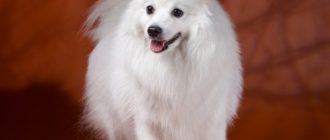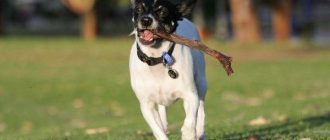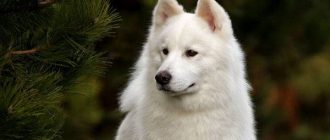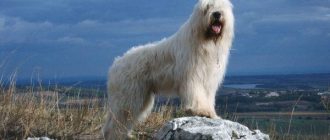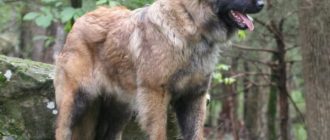Smart, faithful, reliable, unpretentious – all these characteristics relate to the Icelandic dog, which is firmly occupied its place in the hearts of dog breeders. Animals of this breed are famous its flexible nature and ease of care. It’s also very lovely and friendly pets, which is important for those who have the family has children.
Content
- 1 Historical background of the breed
- 1.1 Video: A brief description of the Icelandic Shepherd
- 2 Characteristics of the dog
- 3 Temperament and character
- 4 Puppy Selection
- 5 Care and maintenance
- 5.1 Hygiene
- 5.2 Power
- 5.3 Maintenance in the apartment and walking
- 5.4 Pregnancy and childbirth
- 6 Education and training
- 7 Health
- 7.1 Table: vaccination schedule for an Icelandic dog
Historical background of the breed
Contents
Icelandic dog, shepherd husky, Icelandic spitz, Icelandic a shepherd is all the names of one breed, which has appeared a lot centuries ago. There is an assumption that in Iceland the ancestors of this dogs sailed with the Vikings around the 9th – 10th centuries. Some cynologists believe that the breed appeared by crossing Norwegian Buhund with local dogs.
Subsequently, the shepherd’s husky breed was formed by natural selection of individuals that were most adapted for living in a difficult climate of those places. Since the root the population of Iceland was mainly engaged in farming (and more specifically – breeding livestock), the most appreciated in dogs qualities of a shepherd.

Icelandic dog has adapted well to adverse weather conditions in Iceland
Traditionally, it was the duty of shepherd dogs to accompany cattle on pasture and home, protect them from predators and strangers. FROM the Icelandic dogs coped with their duties so good that enjoyed the great love of the population.
There is historical evidence that these animals were buried. after death with all honors, and during one of the hungry years in Iceland, when people did not disdain even the meat of dogs, this they didn’t touch the breed.
In the Middle Ages, when it began to spread everywhere cattle breeding, Icelandic dogs began to be exported to countries Of Europe. These animals were especially loved by farmers. Great Britain.
In the 19th century, the existence of the breed was threatened. In the country a severe plague epidemic erupted, from which a large number of dogs. But Icelandic huskies were saved.
After a large number of these dogs were lost, in the country began to import animals from abroad. This led to reduction in the number of purebred Icelanders. Therefore, in 1901 a ban was introduced on the import of animals from abroad.
Find a purebred Icelandic shepherd’s husky after the plague epidemic it was very difficult. The price for one puppy was equivalent to the cost horses or several sheep.
Slowly but surely, the breed was reborn. In 1969 was established Icelandic Dog Association. And in 1979 – Shepherd Club Icelandic breed. The world breed standard was adopted in 1898 in Denmark.
Currently, the Icelandic dog is part of the cultural Icelandic heritage. In 2017 at the International Organization about 16 thousand individuals were registered in the Icelandic shepherd, who live in 11 countries. Most Icelandic Spitz bred in Iceland, Denmark and Sweden.
Video: a brief description of the Icelandic shepherd
Dog characteristics
Externally, the Icelandic Spitz is strong, strong, well-built dog. Medium-sized (growth at the withers of males is 46 cm, and female – 42 cm). Males have a more muscular physique, and females are more elegant. The weight of an adult dog is from 12 to 15 kg. Icelanders (Icelandic shepherds) live an average of 12-14 years.
Distinguish between short-haired and long-haired representatives of this breed. The main requirement is a double thick coat, which does not leaks water. Keeping heat well helps thick undercoat.
The color of the dogs of the Icelandic breed can be very diverse. Most common black, gray, brown. At most individuals have white marks on their chests, muzzle or limbs. Often, light-colored dogs have spot in the form of a black mask on the face.
If you want to look at the most unusual colors of dogs, We recommend that you familiarize yourself with articlehttps: //kot-pes.com/neobychnyy-okras-sobak/
Icelanders’ ears have a triangle shape with slightly rounded make ends. The tail is ring-shaped, high-set, reaches up to backs.

The color of Icelandic dogs can be very different.
Temperament and character
Icelandic dogs are characterized by:
- quick wits;
- friendliness;
- sociability;
- agility;
- stamina;
- playfulness;
- love for children;
- vigilance.
The living nature of the dog of this breed does not allow the animal to sit on location. Therefore, maintenance in residential conditions is undesirable. But if the dog still lives in the apartment, then it needs to be provided long walks with high physical activity to the beast could run on plenty.
Shepherd likes are very loyal to their master. They can not to exist without communication with a person. Dogs of this breed are ready follow your master wherever he goes, constantly. therefore raising a puppy, you need to teach him a few hours to be alone, without the company of man.
The dog breed Icelandic Spitz is used as:
- shepherd dog;
- guard dog;
- companion dog;
- family dog.
Icelander gets along well with other animals. And not even chases cats, which is not characteristic of other dogs.
Since the Icelandic dog for many centuries watched after the herd, she learned to use her voice for direction of cattle in the right direction. Therefore, barking in the house where he lives Icelander, a frequent phenomenon. This fact should be considered by those with neighbors can not stand the noise.
An unusual characteristic of a dog of this breed is that she always reacts aggressively to anything approaching her from above. This is due to the instinct developed by centuries of work on a pasture that helped the animal protect the young livestock cattle from the attack of large birds of prey.
Well-bred dogs do not show unreasonable aggression. They express it only in case of danger.
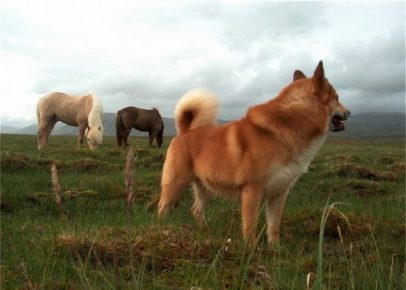
Icelandic dogs get along well with other pets
Puppy selection
Choosing a cute baby – a puppy of an Icelandic shepherd dog – It is necessary to pay attention to the following points:
- all puppies of Icelanders are very curious. Seeing a stranger they confidently run to get to know him. Fear and aggressiveness towards a person is a sign that this the puppy should not be taken;
- the baby’s tail should stick over his back. This indicates that the animal does not bother anything. Otherwise tail will hang;
- by the time the puppy is acquired (this age is 2 months) he should be vaccinated.
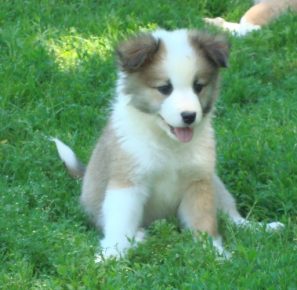
Puppies of the Icelandic shepherd dog are very curious and friendly
Care and maintenance
Icelandic dogs are unpretentious, caring for them minimized and not be difficult.
Hygiene
Hair care involves periodic combing. The regularity of the procedure will reduce the likelihood of mats of wool and remove accumulated dirt. Enough to comb Icelander once a week. But during molting (in spring and autumn) the procedure has to be carried out more often. Shearing this breed does not practiced.
Clipping of claws is performed as they grow. Do not neglect the procedure, because cases are not uncommon ingrowth of claws in the fingertip.
Washing the dog is often not recommended. Frequent bathing leads to that washed off the natural protective grease film on the skin animal. As a result, the skin becomes dry and irritated, the dog’s resistance to frost is reduced.
Auricles need to be cleaned 3-4 times a month. Eyes wiped as they appear on the discharge.
Read more about how to clean your dog’s ears. articlehttps: //kot-pes.com/kak-chistit-ushi-sobake/
To prevent the occurrence of fleas and ticks, it is necessary use special collars or repellents (means from insects).

Hygienically caring for an Icelandic dog is minimized: regular brushing, ear cleaning and nail clipping
Food
Icelanders are unpretentious in food. Their diet should be all products that are on the menu of other dogs, namely:
- meat;
- eggs
- dairy products;
- a small amount of cereals;
- vegetables are rare.
Ready-made dog food is selected individually.
Puppies nutrition for up to 9 months is 4 to 6 meals. Then gradually the dog is transferred to two meals a day.
In addition to food, the veterinarian may prescribe complex vitamins.
Since this breed comes from Iceland, rich in fish, then often Icelandic dogs are willing to exchange a piece of meat for it.

Many Icelandic dogs are ready to exchange a piece of meat for fish
Maintenance in the apartment and walking
The best place to keep an Icelandic shepherd dog is a private house. This breed needs to move a lot and be on nature. But in the apartment the dog can also be kept. but it is necessary to provide her with the opportunity to warm up in the fresh air. Walks should be long – at least 2-3 hours a day. The dog needs to run a lot without a leash, thereby quenching thirst movement.
About more suitable dog breeds for keeping in the apartment you can discover here: https: //kot-pes.com/porody-sobak-dlya-kvartiry-15-luchshix-variantov/
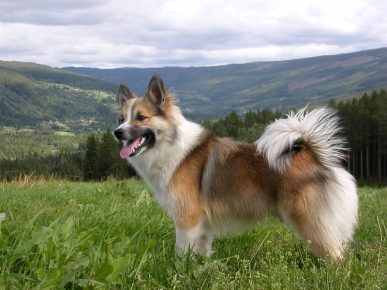
Icelandic dog needs to be outdoors a lot
Pregnancy and childbirth
Pregnancy in dogs lasts 56–72 days. Number of puppies in litter depends on the age of the female. The maximum number of puppies born in dogs 3-4 years of age. During pregnancy special attention must be paid to the nutrition of the expectant mother.
During childbirth, the female becomes anxious. Due to strong emotional connection of the dog with the owner, his excitement is transmitted to her. Therefore, the owner of the animal must be prepared for adoption childbirth and be calm so that the pet does not experience even more severe anxiety.
Parenting and training
The training of an Icelandic dog begins very early. She is very good at training. Great memory helps fast memorize a large number of teams. Strong attachment to man and vulnerability impose restrictions on strict methods training. Promotion methods are best suited for this dog. treats and praise. An animal of this breed can be easily trained unusual tricks that it will easily perform due to their intelligence, mobility and dexterity.
Health
Icelandic dogs are in good health. But in rare cases may be observed:
- dislocation of the patella;
- dysplasia (abnormal development) of the hip and elbow joints
- tendency to eye diseases in older dogs.
Icelanders are vaccinated for all dogs vaccination calendar.
The most popular vaccination schedule is presented in the table below, but you need to know that the veterinarian may offer another option vaccination.
Table: vaccination schedule for an Icelandic dog
| Age | Vaccination |
| 6 weeks | Plague, Parvovirus |
| 8–9 weeks | Plague, parvovirus, hepatitis, parainfluenza, adenovirus |
| 12 weeks | Booster vaccination |
| 6 months | Rabies |
| 1 year | Rabies, leptospirosis |
| 3 years | Revaccination for all diseases, including leptospirosis and parainfluenza conducted every year |
Icelandic dogs are wonderful four-legged friends with a long history of the breed. Cheerfulness, boundless love for to the owner, devotion and kindness make the dogs of this breed ideal pets Icelandic shepherd like will suit the active, ready for long walks in the fresh air.

